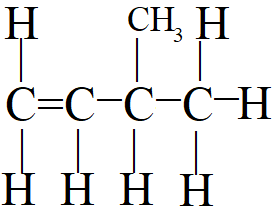
IUPAC name of this compound
Answer
504.9k+ views
Hint- In order to determine the IUPAC name of given carbon structure first we will understand what is the process to give an IUPAC name of any carbon structure then according to it we will write the IUPAC name of given structure.
Complete answer:
Here is simple list of rules to follow to write the IUPAC name of any carbon structure-
1. Identify the longest carbon chain. This chain is called the parent chain.
2. Identify all of the substituent (groups appending from the parent chain).
3. Number the carbons of the parent chain from the end that gives the substituent the lowest numbers. The sequence which is the "lowest" when comparing a set of numbers is the one which includes the lowest number at the first discrepancy. If two or more side chains are equivalent, assign the lowest number to the one that comes first in the name.
4. If the same substituent occurs more than once, the position is given for any point where the substituent occurs. Alternatively, a suffix (di, tri, tetra, etc.) specifies the number of times the substituent group exists.
5. If two or more separate substituents occur, they are described in alphabetical order using the name of the base (neglect the prefixes).
Apart from these rules there are some more rules as well.
The structure of given compound is:

Here from the structure we find the number of carbon in the longest chain is 4 so the name will have “but” also there is a presence of double bond so the name “butene”. Apart from these there is a presence of methyl group at the third carbon so, the prefix “3-methyl”
Hence, the IUPAC name of the given compound is “3-methyl Butene”
Note- The IUPAC nomenclature of organic chemistry is a chemical nomenclature method for organic chemical compounds, as recommended by the International Union of Pure and Applied Chemistry (IUPAC). It is published in the Organic Chemistry Nomenclature (informally named the Blue Book). Ideally, any conceivable organic compound should have a name with which to build an unmistakable structural formula. Some of the rules are mentioned in the solution, students must remember these rules in order to name a compound.
Complete answer:
Here is simple list of rules to follow to write the IUPAC name of any carbon structure-
1. Identify the longest carbon chain. This chain is called the parent chain.
2. Identify all of the substituent (groups appending from the parent chain).
3. Number the carbons of the parent chain from the end that gives the substituent the lowest numbers. The sequence which is the "lowest" when comparing a set of numbers is the one which includes the lowest number at the first discrepancy. If two or more side chains are equivalent, assign the lowest number to the one that comes first in the name.
4. If the same substituent occurs more than once, the position is given for any point where the substituent occurs. Alternatively, a suffix (di, tri, tetra, etc.) specifies the number of times the substituent group exists.
5. If two or more separate substituents occur, they are described in alphabetical order using the name of the base (neglect the prefixes).
Apart from these rules there are some more rules as well.
The structure of given compound is:

Here from the structure we find the number of carbon in the longest chain is 4 so the name will have “but” also there is a presence of double bond so the name “butene”. Apart from these there is a presence of methyl group at the third carbon so, the prefix “3-methyl”
Hence, the IUPAC name of the given compound is “3-methyl Butene”
Note- The IUPAC nomenclature of organic chemistry is a chemical nomenclature method for organic chemical compounds, as recommended by the International Union of Pure and Applied Chemistry (IUPAC). It is published in the Organic Chemistry Nomenclature (informally named the Blue Book). Ideally, any conceivable organic compound should have a name with which to build an unmistakable structural formula. Some of the rules are mentioned in the solution, students must remember these rules in order to name a compound.
Recently Updated Pages
Master Class 12 Economics: Engaging Questions & Answers for Success

Master Class 12 Maths: Engaging Questions & Answers for Success

Master Class 12 Biology: Engaging Questions & Answers for Success

Master Class 12 Physics: Engaging Questions & Answers for Success

Master Class 11 English: Engaging Questions & Answers for Success

Master Class 11 Computer Science: Engaging Questions & Answers for Success

Trending doubts
The gas that burns in oxygen with a green flame is class 12 chemistry CBSE

Most of the Sinhalaspeaking people in Sri Lanka are class 12 social science CBSE

Give 10 examples of unisexual and bisexual flowers

Draw a labelled sketch of the human eye class 12 physics CBSE

Differentiate between homogeneous and heterogeneous class 12 chemistry CBSE

Write a short note on Franklands reaction class 12 chemistry CBSE




